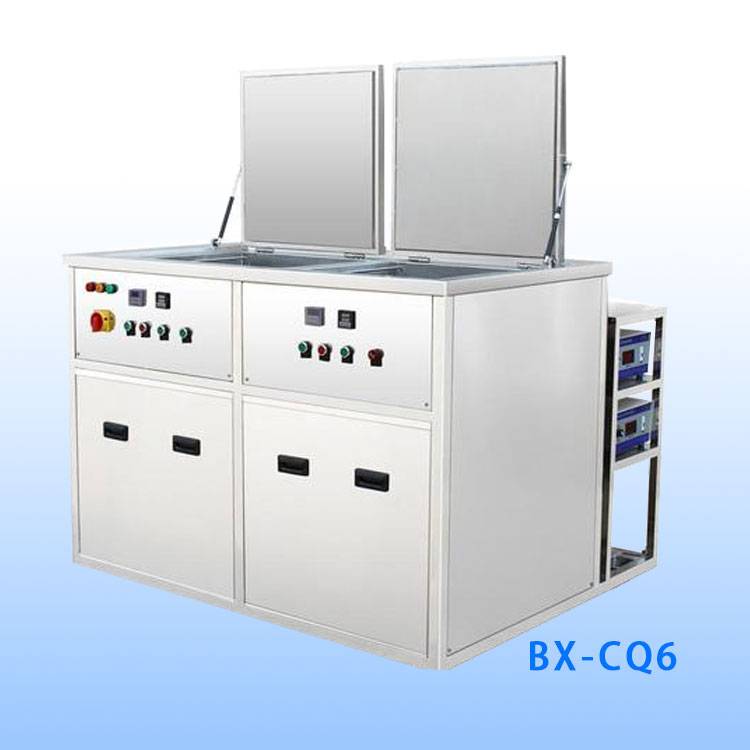
The ultrasonic wave propagates in the liquid, so that the liquid and the cleaning tank vibrate together at the ultrasonic frequency. The liquid and the cleaning tank vibrate at their own natural frequency. This vibration frequency is the frequency of sound waves, so people hear the buzz. With the continuous development of the cleaning industry, more and more industries and enterprises use the ultrasonic cleaning machine.
On the principle of ultrasonic cleaning machine issued by the ultrasonic generator of high frequency oscillation signal, through the transducer converted into high frequency mechanical oscillation and spread to the medium - cleaning solvent, ultrasonic in cleaning liquid density phase forward radiation, so that the liquid flow and produce tens of thousands of small bubbles with a diameter of 50-500μm, Tiny bubbles of air present in a liquid vibrate under the action of an acoustic field. These bubbles form and grow in the negative pressure region where the ultrasonic wave propagates longitUDinally, while in the positive pressure region, when the sound pressure reaches a certain value, the bubbles increase rapidly and then suddenly close. When the bubble is closed, a shock wave is generated and thousands of atmospheres of pressure are generated around it, which destroys the insoluble contaminants and makes them dispersed in the cleaning fluid. When the group particles are coated with oil and adhere to the surface of the cleaning part, the oil is emulsified and the solid particles are separated, so as to achieve the purpose of cleaning the cleaning part. In this process, known as the "cavitation" effect, bubbles close to produce temperatures of several hundred degrees and transient pressures of more than 1,000 atmospheric pressures.
The advantages of ultrasonic cleaning machine are: ultrasonic cleaning effect is good, simple operation. The sound that people hear is the sound wave signal with a frequency of 20-2000Hz, and the sound wave higher than 2000Hz is called ultrasonic wave. The transmission of the sound wave propagates longitudinally according to the sinusoidal curve, producing a large number of small bubbles. One reason is the local tensile stress in the liquid and the formation of negative pressure, the reduction of pressure so that the original dissolved in liquid gas supersaturated, and escape from the liquid, become small bubbles; Another reason is that strong tensile stresses "tear" the liquid into a void, known as cavitation.
The main parameters of ultrasonic cleaning machine
1. Frequency: ≥20KHz, can be divided into low frequency, medium frequency, high frequency 3 segments.
2. Cleaning medium: the use of ultrasonic cleaning, general two kinds of cleaning agent: chemical solvent, water-based cleaning agent, etc. The chemical action of cleaning medium can accelerate the effect of ultrasonic cleaning. Ultrasonic cleaning is a physical effect. The two effects are combined to fully and thoroughly clean the object.
3. Power density: power density = transmitting power (W)/transmitting area (cm²) is usually ≥0.3W/cm². The higher the ultrasonic power density, the stronger the cavitation effect, the faster the speed, and the better the cleaning effect. However, for precise, high surface finish objects, using a long time of high power density cleaning will produce "cavitation" corrosion on the surface of the object.
4. Ultrasonic frequency: the lower the ultrasonic frequency, the easier the cavitation produced in the liquid, the greater the intensity, the stronger the effect is, which is suitable for the first cleaning of the workpiece (coarse and dirty). High frequency is strong ultrasonic direction, suitable for fine object cleaning.
5. Cleaning temperature: Generally speaking, ultrasonic cavitation at 30℃-40℃ is the best. The higher the temperature of the cleaning agent, the more significant the effect. Usually the actual application of ultrasonic, the use of 50℃-70℃ working temperature.
Application field
Ultrasonic cleaning machine is widely used in surface spraying processing industry, machinery industry, electronics industry, medical industry, semiconductor industry, watch and jewelry industry, optical industry, textile printing and dyeing industry. In other industries, the use of ultrasonic cleaning machine is as follows
1, surface spraying treatment industry: (cleaning attachments: oil, mechanical chips, abrasives, dust, polishing wax) before the removal of carbon deposition, removal of oxide scale, removal of polishing paste, removal of oil and rust, ion plating before cleaning, phosphating treatment, metal workpiece surface activation treatment, etc. Stainless steel polishing products, stainless steel cutting tools, tableware, cutting tools, locks, lighting, hand decoration before spraying treatment, cleaning before electroplating.
2, machinery industry: (cleaning attachments: cutting oil, abrasive particles, iron filings, dust, fingerprints)
Removal of antirust grease; Cleaning of measuring tools; Oil removal and rust removal of mechanical parts; Engine, engine parts, gearbox, shock absorber, bearing bracket, nozzle, cylinder block, valve body, carburetor and auto parts and chassis before oil removal, rust removal, phosphating cleaning; Filter, piston accessories, filter cleaning and so on. Precision mechanical parts, compressor parts, camera parts, bearings, hardware parts, molds, especially in the railway industry, are very suitable for oil removal and decontamination of air conditioning in train compartment, rust prevention, rust removal and oil removal of various parts of the train locomotive.